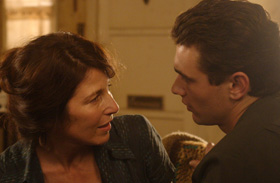Mindset into madness lacks insight.
It’s difficult to fathom that there was once an era when adults had the monopoly on what was common sense and where teens relinquished all rights and weren’t the authoritative, outspoken or the domineering individuals that is the mainstay today. Pulling from a 60’s newspaper headline and from accompanying court testimonies, Tommy O’Haver gets the opportunity to think outside the box of his usual repertoire of safe family fare for a significant shift in tones. Brimming in despair and psychological sadism, An American Crime might thankfully avoid the graphic exploitative nature of the crimes committed by one Gertrude Baniszewski and co. onto one Miss Sylvia Likens, but mysteriously, not many liberties are taken in penetrating the psychosis of these characters.
Introduced as a narrated, “this is my story†trip down memory lane, innocence lost begins with the aforementioned film’s title but artistically begins with a merry-go-round inside a traveling amusement park. This slow-motion scene that bookmarks the film is the first and last pleasures before the descent into hell. Wearing their identity tags as victim and victimizer, from early on when a struggling mother of 7 children adds plus 2, then the homey comforts of family are moments away from heinous crimes.
Written by O’Haver and Irene Turner, this pieces together the escalation of violence, the puzzling reactions and non-reactions of the children and interjects a collage of court scenes that could have easily have been replaced by fades to black.
A distilled and blank-stared Catherine Keener and her counterpart in Ellen Page’s role as a human punching bag/ashtray offer two promising performances that are kept hog-tied, with only cues into the mother’s conflicting thoughts about promiscuity and redemption in front of the eyes of the lord as the motivations behind cruel discipline, O’Haver avoids commentary and thus audiences will have a hard time making an association between why the children act out the same savagery as the mother and the breaking point of when sanity becomes insanity is pointed to a drug prescription bottle gone unfilled.
Scenes are held long and dramatically they serve the purpose of reminding the viewer of Baniszewski’s amorous hatred for her victim – of the same gender. Atmospherically, O’Haver first introduces a bright color palette with healthy natural sunlight and this slowly recedes to an emphasis on shadowing. The little shop of horrors is leagues away from normalcy; via cinematographer Byron Shah’s compositions O’Haver deftly explores that last ounce of hope – one deafening shot from the point of view of a gaze from a basement window into the sole window on the ground floor. The shot is a creepy and cryptic in the same stance because those who do the torturing run freely inside this spatial area that symbolizes freedom.
This art-house film boosts a pair of convincing performances, together Keener and Page show the imprint of devastation – but the screenplay offers no recourse in how to interpret the court transcripts of the case and the film takes very little liberties into defining such characters beyond the brutality. Audiences might ultimately find it difficult to find any redeeming value here – all the sadism and psychological torture of this bizarre case – only demands more clarification and not necessarily more discussion.
Sundance 2007 – Jan.20th
